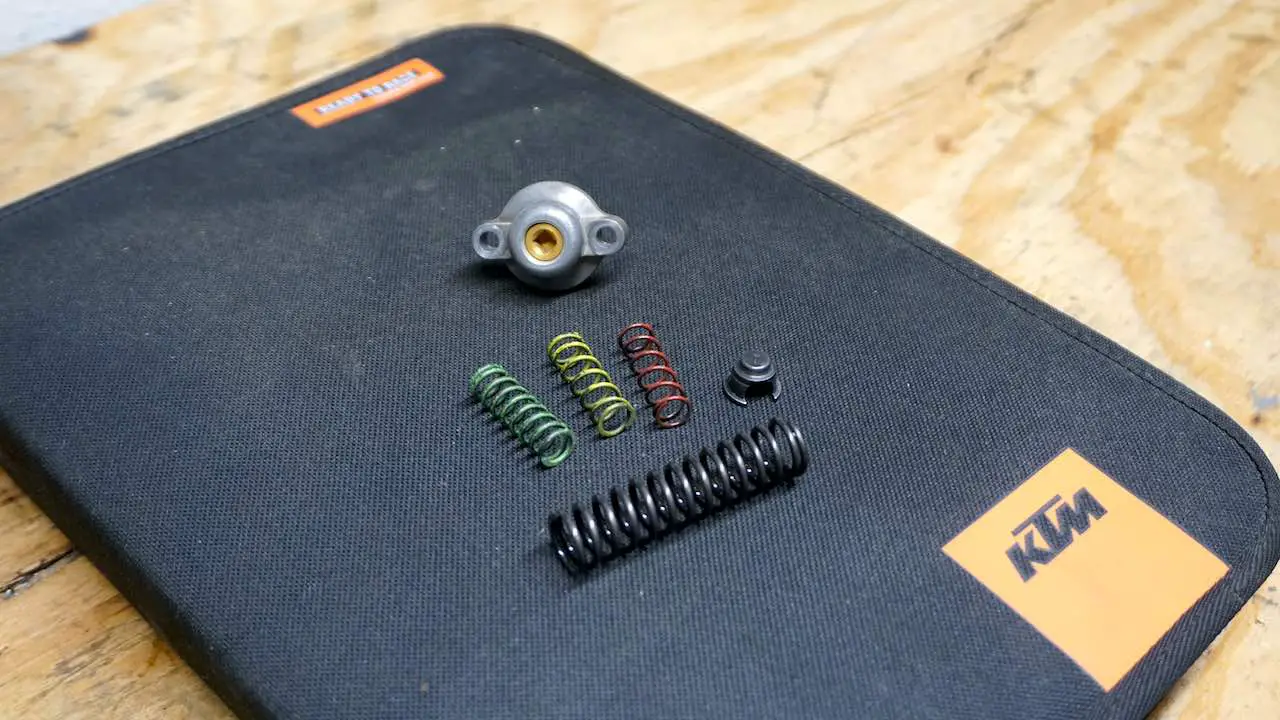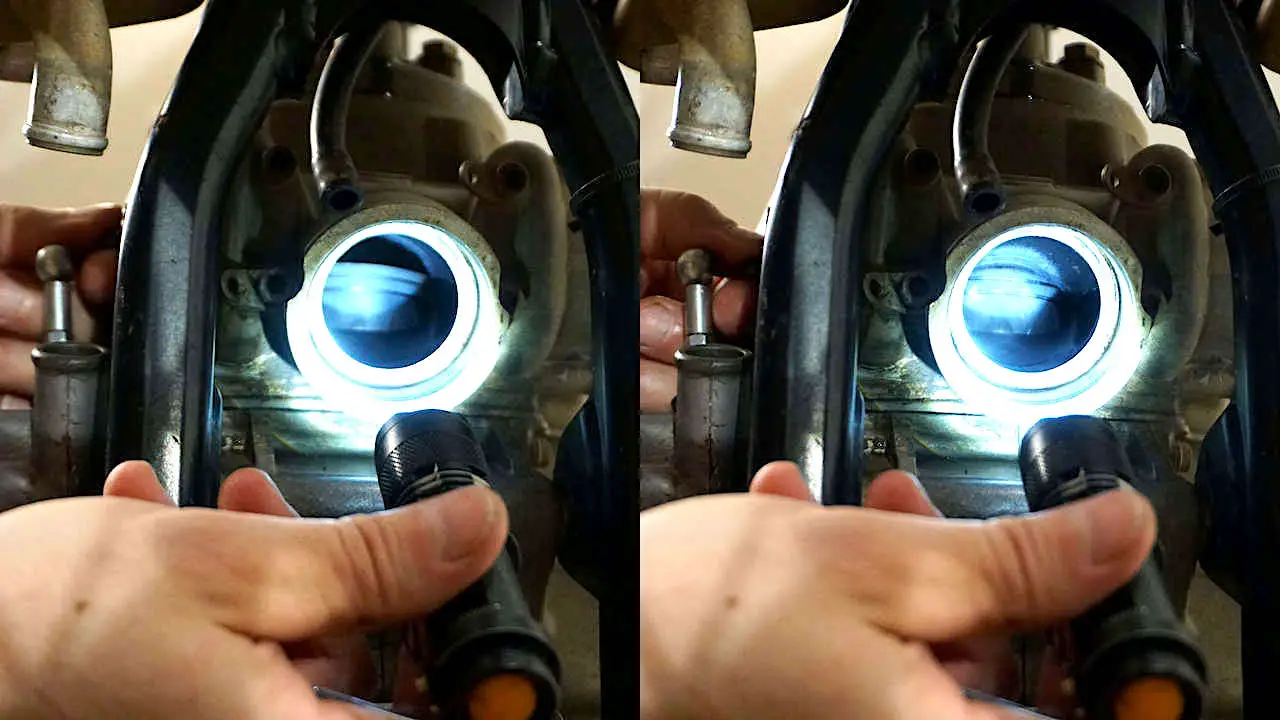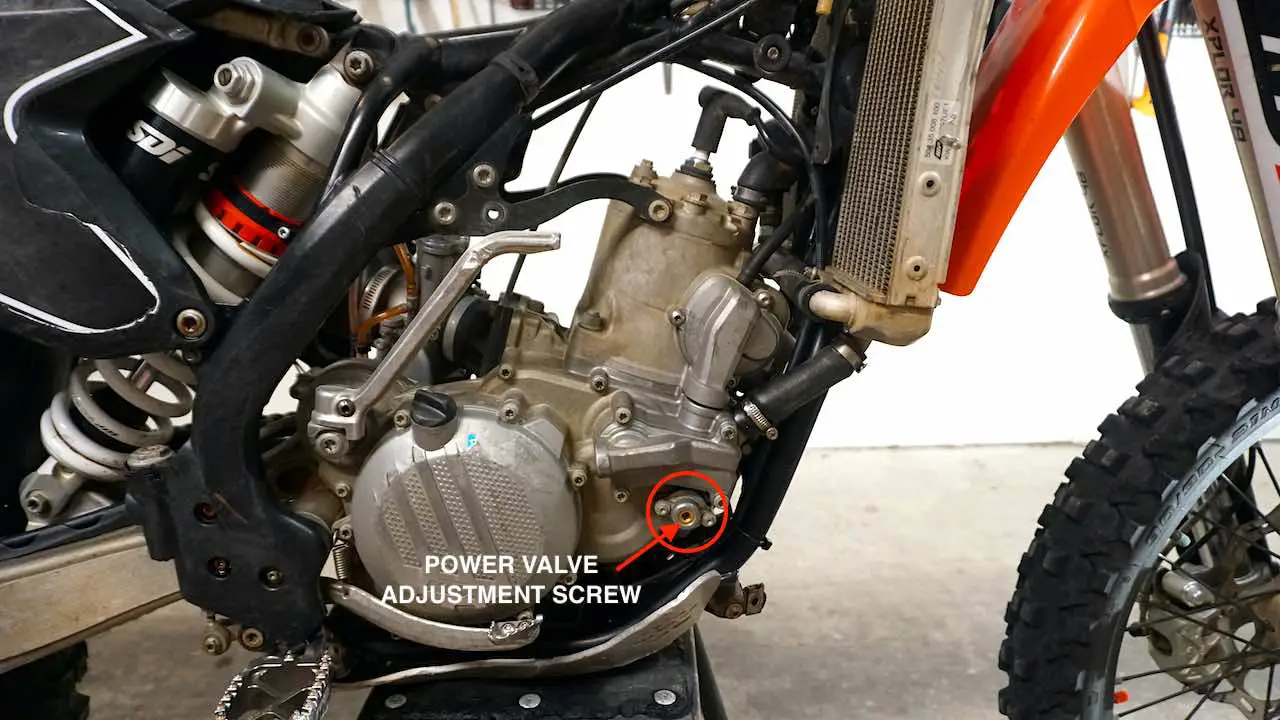Most modern two-stroke dirt bikes are equipped with an adjustable 2 stroke power valve. It makes it possible to fine-tune the engine characteristics and power delivery to match your riding style and preferences.
The 2 stroke power valve is a flap in the exhaust port that changes the exhaust port size in two-stroke engines based on the engine revolutions. This provides the engine a much more controllable and tunable power curve and enables an increased low-end torque while opening up more airflow in higher revs for maximum power.
In this article we will explain:
- What exactly is a 2 stroke power valve
- How does the 2 stroke power valve work
- Why should you adjust the power valve
- How to adjust the 2 stroke power valve
- and much more!
Adjusting the power valve is quick and easy. Next, we will explain how the 2 stroke power valve works as well as why and how you should adjust it.
This post contains affiliate links. If you use these links to buy something we may earn a commission at no additional cost to you. As an Amazon Affiliate we earn from qualifying purchases.

What Exactly Is a 2 Stroke Power Valve?
A 2 stroke power valve is a mechanical flap that rotates in front of the cylinder in the exhaust port. It controls the exhaust port size or height in relation to the engine RPMs.

The 2 stroke power valve enables a variable exhaust port height and size. Additionally, the variable exhaust port size is used to generate more torque and more power in different RPM range. The power valve is thus used to fine-tune more controllable engine torque and power delivery out of the motor. For more information on 2 stroke power valves, check Wikipedia article on 2 stroke power valves here.
How Does a 2 Stroke Power Valve Work?
A power valve controls the amount of air the two-stroke engine is able to push through the motor at any given RPM range as well as the back-pressure inside the cylinder . The bigger the exhaust port, the more air is pushed out and more air fuel mixture is sucked in to generate more power.
By adjusting the exhaust port size with the power valve, you can tune the engine to your liking and riding style.

The power valve can be externally adjusted in two ways:
- Changing the power valve spring to a softer or stiffer spring will affect the power valve opening speed. This is described in the top half of the picture above.
- Changing the spring preload with the dolly or Robertson head screw will affect the RPMs when the power valve starts opening. This is described in the lower half of the picture above. Furthermore, tightening the screw clockwise will delay the power valve opening (less power at lower RPMs) and loosening the screw will make the power valve open sooner (more power for lower RPMs).
Power valves are controlled by either a mechanical push rod or an electrical motor. Similarly, in both configurations, they can usually be tuned fairly easily either mechanically or with ECU tuning.
Note: In TPI dirt bikes you will likely only have the preload adjustment screw and not separate springs.
Why Should You Adjust the 2 Stroke Power Valve?
There are several reasons why you should consider testing different settings and tuning the power valve on your two-stroke dirt bike.
But in a nutshell, when your dirt bike is set up for your specific style of riding and terrain, you will get the most out of your dirt bike.
Let’s take a look at the different benefits you can get from adjusting the power valve.
1. Tame Down the Power Delivery for Beginner Riders
Adjusting the power valve to a more controllable power can help make the dirt bike much easier to handle for beginner riders.
Additionally, two-strokes tend to be intimidating for some riders. For example, being able to tune down the maximum power and the area where the power valve flap fully opens helps making the dirt bike easier to ride.
2. Adjust the Power Delivery for Your Riding Style or Trails
If you ride slower, more technical single tracks, you may want to tune the engine to produce a reliable low-end torque.
Adjusting the power valve to open higher in the revs range can help maximize the traction. Faster trails and especially sandy trails usually call for maximum power and tuning the power valve to open early and fully would make the dirt bike perform much better in these conditions.
3. Low Traction Conditions
The power valve adjustment also comes handy when riding in wet, rainy muddy, or otherwise very slippery trails conditions.
Especially if your dirt bike doesn’t have a rain mode mapping available, the power valve can really help maximize traction by slowing the power valve function down.
4. Maximum Power Conditions
As mentioned before, in desert style riding, in motocross, and on similar fast, wide open trails, you will want more power. Typically, these are maximum power conditions and ask for more power and torque our of the dirt bike.
So, to achieve this, many riders install the red spring and adjust the power valve preload to a desired setting to maximize the engine power.
How To Adjust the 2 Stroke Power Valve
You can tune the engine power delivery characteristics by tuning the exhaust power valve in two different ways:
- Adjusting when the power valve is fully open in the motor revolution range. For example, you can tune the power valve to open fully at 6500 RPMs. To achieve this, you will rotate the power valve spring preload adjustment screw.
- Adjusting the speed of the power valve opening or how quickly the valve will be opening. For example, you can tune the power valve to start opening at 5500 RPMs and be fully open at 7200 RPMs. To achieve this, you need to replace the power valve spring with a softer or stiffer spring.
Both of these methods will change the motor power delivery curve.
Tools Needed for a 2 Stroke Power Valve Adjustment
The power valve adjuster has a square dolly screw that requires a special tool. You can adjust it with a flathead screwdriver, but you should use the tool to avoid stripping the adjuster.
The KTMs and Husqvarnas will use the same size and style 2 stroke power valve adjustment tools. In our case, this KTM power valve adjuster (click to check the current price on Amazon.com) works well as its small and can be packed to the trail backpack of trailside adjustments.
1. Adjust the 2 Stroke Power Valve Preload Screw
The 2 stroke power valve preload adjustment screw or dolly screw is typically located on the right side of the motor.

The power valve adjustment screw calls for a special tool in KTM and Husqvarna engines. Additionally, the KTM power valve adjustment and the tuning principles are similar to other 2 stroke dirt bikes.
To sum up, turning the adjustment screw in clockwise direction will add more preload. Furthermore, this means that you are delaying the power valve opening and moving the power punch higher in the RPM range.
Additionally, opening the screw counterclockwise will lower the power valve spring preload making the power valve open quicker in the lower RPM range.
Finally, your owner’s manual should give you a good starting point on the factory settings. They usually tell you the rotations in from flush with the screw housing or you can measure the distance from flush with a digital caliper.
2. Change the 2 Stroke Power Valve Spring
The different color auxiliary springs are used to control the power valve opening speed. The green, yellow, and red springs are rated different and usually the green spring is the stiffest or hardest to compress and also larger in size. The yellow spring is a mid-range and the red one is the softest spring.
Think of the springs working as a resistance to opening the power valve. More stiffer the spring, the more pressure it needs to open. The adjustment screw will fine-tune the chosen spring together with a second, larger spring installed on the outside of the auxiliary spring.

The power valve secondary spring sits under the adjustment screw closing cover. Underneath, you will find two springs: the outer larger adjusting spring and the auxiliary spring around the spring thrust bearing.
You can open the power valve cover by removing the two bolts and pulling out the closing cover. Change the auxiliary spring to either a green, yellow, or red spring and reinstall the closing cover. Readjust the power valve screw to 1.5 turns in from flush or to your owner’s manual recommended setting.
Tips on How To Begin, Test, and Fine-tune Power Valve Settings
First, begin by installing the yellow spring. Secondly, adjust the power valve adjustment screw to 1.5 turns in from flush. Thirdly, find a short trail loop or test track and warm up. Finally, ride few laps and adjust the power valve quarter turn at a time and test again. How did that feel? Can you tell the power burst coming in later or sooner in the RPMs?
Continue testing different settings until the power comes on at a desired RPM level. If the dirt bike feels like needing more aggressive power delivery, change to the red spring and repeat. For a more tame and controllable power delivery, change to the yellow or green spring and re-test.
Our Recommended 2 Stroke Power Valve Settings
There are many ways to adjust the power valve. It all depends on your riding style and how long you have been riding—in other words your riding level.
The key is to try different settings and figure out what works the best for you. What works for your riding buddy doesn’t necessarily work for you.
Below you will find great starting settings for different riding styles and rider levels.
2 Stroke Power Valve Settings for Beginner Level Riders
If you are a beginner rider, start with the green spring and set the 2 stroke power valve adjustment screw to factory setting. This is usually 1.5 turns in from flush. This tames the motor down to a very manageable power setting and is more forgiving when learning the basic techniques.
With 250 and 300cc motors you may want to turn the power valve adjustment screw in 2.5 turns to push the power valve opening higher in the RPM range to tame the power curve even more.
2 Stroke Power Valve Settings for Advanced Level Riders
Advanced riders will quickly start benefiting from a more high-end, controllable power delivery. Change the 2 stroke power valve spring to a yellow spring and play around with the adjustment curve to find the best RPM range to your liking.
Some conditions will require more high-end max power whereas some conditions benefit from more delayed response to the RPMs. You will be amazed how much the power delivery and feeling will change, so try out several settings and keep a log for future use.
2 Stroke Power Valve Settings for Hard Enduro Riders
Setting up your dirt bike for hard enduro or racing should involve tuning the 2 stoker power valve and the power delivery to match the track or trail type and conditions.
It’s not easy to create a good thumb rule for the power valve settings that would work well in all conditions. Testing is definitely required and with experience you will find settings that will work for you in different conditions.
More power is not necessarily the best choice for most riding conditions. Slippery, slimy, muddy and similar conditions usually call for maximizing the traction and too much power can cause issues.
Our Power Valve Settings for Hard Enduro
Our choice for hard enduro is to use the red spring with 2 turns in from flush on the adjustment screw.
This roughly translates to a highly aggressive maximum power at relatively high RPMs with very controllable low-end torque and a strong mid-range performance.
If the conditions are slippery or wet, we usually throw 1 more turn in on the 2 stroke power valve adjustment screw from flush to push the peak power delivery slightly higher on the revs to avoid wheel slippage.
Conclusions
Two-stroke engines are simple in design, which makes them highly tunable. Thanks to the variable exhaust port enabled by the 2 stroke power valve and the modern engine controlling units, two-stroke engines are pushing more and more horsepower per cubic centimeter and are rivaling even the most powerful four-stroke engines.
Learning how and when to tune the 2 stroke power valve on a two-stroke engine can help you in various ways. It’s quick and easy and you can do it trail-side within 5 minutes.
Keep it pinned and hold on when the power valve opens up!
Read next:
